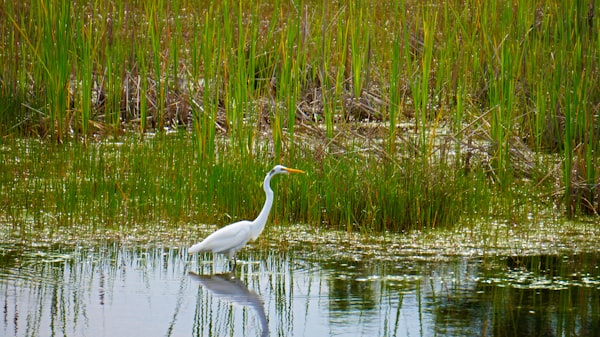Table of contents
The Ramsar Convention on Wetlands of International Importance is an international treaty for the Conservation and Sustainable use of wetlands. It is also known as the Convention on Wetlands. It is named after the city of Ramsar in Iran, where the Convention was signed in 1971.
What is the meaning of Ramsar Sites?
A Ramsar site is a wetland site designated to be of international importance under the Ramsar Convention, also known as "The Convention on Wetlands", an intergovernmental environmental treaty established in 1971 by UNESCO, which came into force in 1975.
- It provides for national action and international cooperation regarding the conservation of wetlands and wise sustainable use of their resources.
- Ramsar identifies wetlands of international importance, rare or unique wetland types or for their importance in conserving biological diversity, especially those providing waterfowl habitat.
It includes all lakes and rivers, underground aquifers, swamps and marshes, wet grasslands, peatlands, oases, estuaries, deltas and tidal flats, mangroves and other coastal areas, coral reefs, and all human-made sites such as fish ponds, rice paddies, reservoirs and salt pans.
Contracting Parties
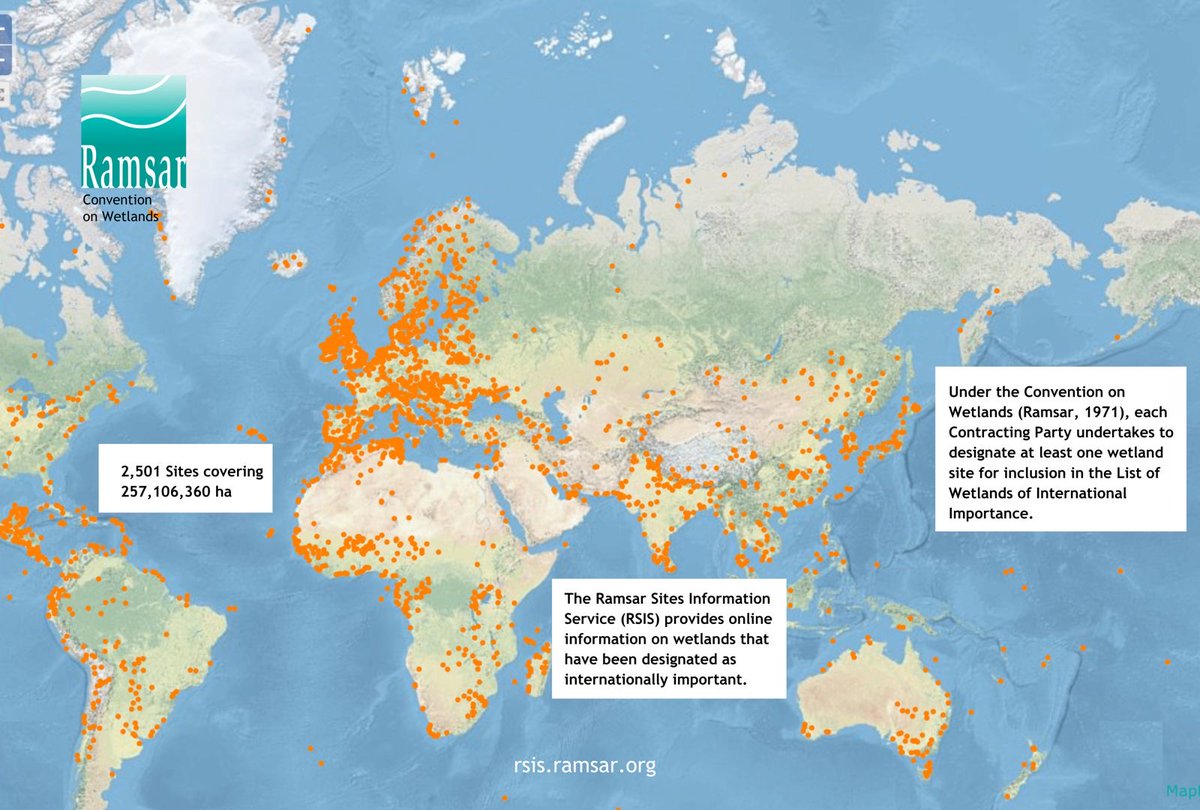
Managing wetlands is a global challenge and the Convention presently counts 172 countries as Contracting Parties, which recognize the value of having one international treaty dedicated to a single ecosystem.
The Contracting Parties approved the Fourth Ramsar Strategic Plan for 2016-2024 at COP12.
- The Plan lays out a new vision under the Convention mission, four overall goals and 19 specific targets which are designed to support the efforts of Parties, partners and other stakeholders in preventing, stopping and reversing the global decline of wetlands.
Under the “three pillars” of the Convention, the Contracting Parties commit to:
- work towards the wise use of all their wetlands;
- designate suitable wetlands for the list of Wetlands of International Importance (the “Ramsar List”) and ensure their effective management;
- cooperate internationally on transboundary wetlands, shared wetland systems and shared species.
At the time of joining the Convention, each Contracting Party must designate at least one wetland site within their territory for inclusion in the List of Wetlands of International Importance (the "Ramsar List").
Implementing the Ramsar Strategic Plan and its goals and targets will also contribute to the achievement of the Sustainable Development Goals (SDGs) and targets.
We can't clear UPSC for you.
But with our personalised mentor support, you'll be ready to do it yourself.
Criteria for Ramsar Sites
| Group A of the Criteria | Sites containing representative, rare or unique wetland types |
|---|---|
| Criteria 1 | A wetland should be considered internationally important if it contains a representative, rare, or unique example of a natural or near-natural wetland type found within the appropriate biogeographic region. |
| Group B of the Criteria | Sites of international importance for conserving biological diversity |
| Criteria based on species and ecological communities | |
| Criteria 2 | A wetland should be considered internationally important if it supports vulnerable, endangered, or critically endangered species or threatened ecological communities. |
| Criteria 3 | A wetland should be considered internationally important if it supports populations of plant and/or animal species important for maintaining the biological diversity of a particular bio geographic region. |
| Criteria 4 | A wetland should be considered internationally important if it supports plant and/or animal species at a critical stage in their life cycles, or provides refuge during adverse conditions |
| Specific criteria on waterbirds | |
| Criteria 5 | A wetland should be considered internationally important if it regularly supports 20,000 or more water birds |
| Criteria 6 | A wetland should be considered internationally important if it regularly supports 1% of the individuals in a population of one species or subspecies of waterbird |
| Specific criteria based on fish | |
| Criteria 7 | A wetland should be considered internationally important if it supports a significant proportion of indigenous fish subspecies, species or families, life-history stages, species interactions and/or populations that are representative of wetland benefits and/or values and thereby contributes to global biological diversity |
| Criteria 8 | A wetland should be considered internationally important if it is an important source of food for fishes, spawning ground, nursery and/or migration path on which fish stocks, either within the wetland or elsewhere, depend. |
| Specific criteria based on other taxa | |
| Criteria 9 | A wetland should be considered internationally important if it regularly supports 1% of the individuals in a population of one species or subspecies of wetland-dependent non-avian animal species. |
List of Ramsar Wetlands Sites in India (As on January 2024)
S. No. | State Location | Name of Site | Date of Declaration | Area |
1 | Andhra Pradesh | Kolleru Lake | 19.8.2002 | 901.00 |
2 | Assam | Deepor Beel | 19.8.2002 | 40.00 |
3 | Bihar | Kabartal Wetland | 21.07.2020 | 26.20 |
4 | Goa | Nanda Lake | 06.08.2022 | 0.42 |
5 | Gujarat | Khijadia Wildlife Sanctuary | 13.04.2021 | 5.12 |
6 | Gujarat | Nalsarovar Bird Sanctuary | 24.09.2012 | 120.00 |
7 | Gujarat | Thol Lake Wildlife Sanctuary | 05.04.2021 | 6.99 |
8 | Gujarat | Wadhvana Wetland | 05.04.2021 | 6.30 |
9 | Haryana | Bhindawas Wildlife Sanctuary | 25.05.2021 | 4.12 |
10 | Haryana | Sultanpur National Park | 25.05.2021 | 1.43 |
11 | Himachal Pradesh | Chandertal Wetland | 8.11.2005 | 0.49 |
12 | Himachal Pradesh | Pong Dam Lake | 19.8.2002 | 156.62 |
13 | Himachal Pradesh | Renuka Wetland | 8.11.2005 | 0.20 |
14 | Jammu and Kashmir | Hokera Wetland | 8.11.2005 | 13.75 |
15 | Jammu and Kashmir | Hygam Wetland Conservation Reserve | 13.08.2022 | 8.02 |
16 | Jammu and Kashmir | Shallbugh Wetland Conservation Reserve | 13.08.2022 | 16.75 |
17 | Jammu and Kashmir | Surinsar-Mansar Lakes | 8.11.2005 | 3.50 |
18 | Jammu and Kashmir | Wular Lake | 23.3.1990 | 189.00 |
19 | Karnataka | Aghanashini Estuary | 31.01.2024 | 48.01 |
20 | Karnataka | Ankasamudra Bird Conservation Reserve | 31.01.2024 | 0.98 |
21 | Karnataka | Magadi Kere Conservation Reserve | 31.01.2024 | 0.54 |
22 | Karnataka | Ranganathittu Bird Sanctuary | 15.02.2022 | 5.18 |
23 | Kerala | Asthamudi Wetland | 19.8.2002 | 61.40 |
24 | Kerala | Sasthamkotta Lake | 19.8.2002 | 3.73 |
25 | Kerala | Vembanad Kol Wetland | 19.8.2002 | 1512.50 |
26 | Ladakh | Tso Kar Wetland Complex | 17.11.2020 | 95.77 |
27 | Ladakh | Tsomoriri Lake | 19.8.2002 | 120.00 |
28 | Madhya Pradesh | Bhoj Wetlands | 19.8.2002 | 32.01 |
29 | Madhya Pradesh | Sakhya Sagar | 01.07.2022 | 2.48 |
30 | Madhya Pradesh | Sirpur Wetland | 01.07.2022 | 1.61 |
31 | Madhya Pradesh | Yashwant Sagar | 13.08.2022 | 8.23 |
32 | Maharashtra | Lonar Lake | 22.7.2020 | 4.27 |
33 | Maharashtra | Nandur Madhameshwar | 21.6.2019 | 14.37 |
34 | Maharashtra | Thane Creek | 13.08.2022 | 65.21 |
35 | Manipur | Loktak Lake | 23.3.1990 | 266.00 |
36 | Mizoram | Pala Wetland | 31.08.2021 | 18.50 |
37 | Odisha | Ansupa Lake | 13.08.2022 | 2.31 |
38 | Odisha | Bhitarkanika Mangroves | 19.8.2002 | 650.00 |
39 | Odisha | Chilka Lake | 1.10.1981 | 1165.00 |
40 | Odisha | Hirakud Reservoir | 13.08.2022 | 654.00 |
41 | Odisha | Satkosia Gorge | 10.12.2021 | 981.97 |
42 | Odisha | Tampara Lake | 13.08.2022 | 3.00 |
43 | Punjab | Beas Conservation Reserve | 26.9.2019 | 64.29 |
44 | Punjab | Harike Lake | 23.3.1990 | 41.00 |
45 | Punjab | Kanjli Lake | 22.1.2002 | 1.83 |
46 | Punjab | Keshopur-Miani Community Reserve | 26.9.2019 | 3.44 |
47 | Punjab | Nangal Wildlife Sanctuary | 26.9.2019 | 1.16 |
48 | Punjab | Ropar Lake | 22.1.2002 | 13.65 |
49 | Rajasthan | Keoladeo Ghana NP | 1.10.1981 | 28.73 |
50 | Rajasthan | Sambhar Lake | 23.3.1990 | 240.00 |
51 | Tamil Nadu | Chitrangudi Bird Sanctuary | 13.08.2022 | 2.60 |
52 | Tamil Nadu | Gulf of Mannar Marine Biosphere Reserve | 04.08.2022 | 526.72 |
53 | Tamil Nadu | Kanjirankulam Bird Sanctuary | 13.08.2022 | 0.97 |
54 | Tamil Nadu | Karaivetti Bird sanctuary | 31.01.2024 | 4.53 |
55 | Tamil Nadu | Karikili Bird Sanctuary | 04.08.2022 | 0.58 |
56 | Tamil Nadu | Koonthankulam Bird Sanctuary | 11.08.2021 | 0.72 |
57 | Tamil Nadu | Longwood Shola Reserve Forest | 31.01.2024 | 1.16 |
58 | Tamil Nadu | Pallikaranai Marsh Reserve Forest | 04.08.2022 | 12.48 |
59 | Tamil Nadu | Pichavaram Mangrove | 04.08.2022 | 14.79 |
60 | Tamil Nadu | Point Calimere Wildlife and Bird Sanctuary | 19.8.2002 | 385.00 |
61 | Tamil Nadu | Suchindram Theroor Wetland Complex | 13.08.2022 | 0.94 |
62 | Tamil Nadu | Udhayamarthandapuram Bird Sanctuary | 04.08.2022 | 0.44 |
63 | Tamil Nadu | Vaduvur Bird Sanctuary | 13.08.2022 | 1.13 |
64 | Tamil Nadu | Vedanthangal Bird Sanctuary | 04.08.2022 | 0.40 |
65 | Tamil Nadu | Vellode Bird Sanctuary | 04.08.2022 | 0.77 |
66 | Tamil Nadu | Vembannur Wetland Complex | 04.08.2022 | 0.20 |
67 | Tripura | Rudrasagar Lake | 8.11.2005 | 2.40 |
68 | Uttar Pradesh | Bakhira Wildlife Sanctuary | 29.06.2021 | 28.94 |
69 | Uttar Pradesh | Haiderpur Wetland | 8.12.2021 | 69.08 |
70 | Uttar Pradesh | Nawabganj Bird Sanctuary | 19.9.2019 | 2.25 |
71 | Uttar Pradesh | Parvati Agra Bird Sanctuary | 2.12.2019 | 7.22 |
72 | Uttar Pradesh | Saman Bird Sanctuary | 2.12.2019 | 5.26 |
73 | Uttar Pradesh | Samaspur Bird Sanctuary | 3.10.2019 | 7.99 |
74 | Uttar Pradesh | Sandi Bird Sanctuary | 26.9.2019 | 3.09 |
75 | Uttar Pradesh | Sarsai Nawar Jheel | 19.9.2019 | 1.61 |
76 | Uttar Pradesh | Sur Sarovar | 21.8.2020 | 4.31 |
77 | Uttar Pradesh | Upper Ganga River | 8.11.2005 | 265.90 |
78 | Uttarakhand | Asan Conservation Reserve | 21.7.2020 | 4.44 |
79 | West Bengal | East Kolkata Wetlands | 19.8.2002 | 125.00 |
80 | West Bengal | Sunderbans Wetland | 30.1.2019 | 4230.00 |
Source: MoEFCC & State Forest Departments
Also read: India adds five wetlands to "Ramsar Sites"
Benefits of Wetland Conservation
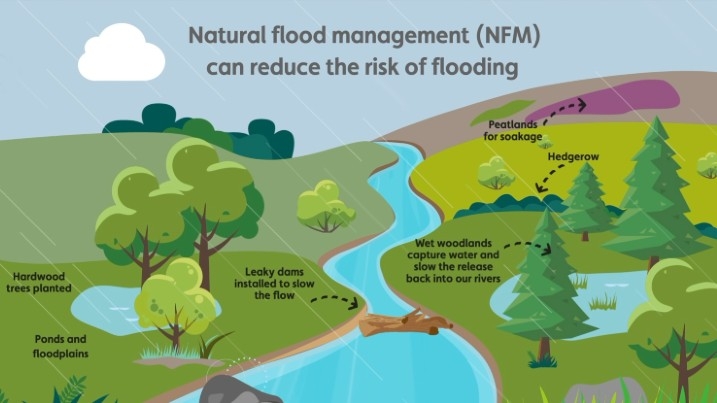
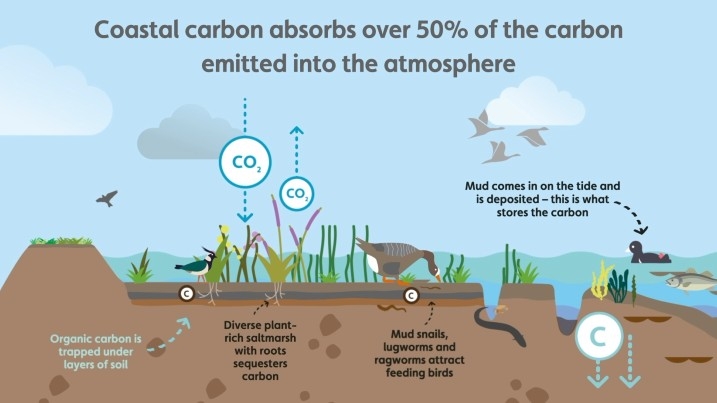
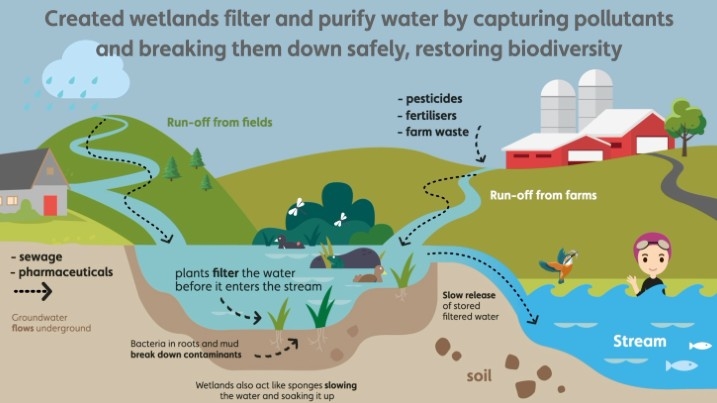
- Increased biodiversity.
- Replenished and filtered water supply.
- Enhanced protection against floods and storms.
- More local and sustainable livelihoods, less poverty.
- Increased tourism, higher quality leisure time.
- Increased carbon storage and avoided emissions.
- Inner satisfaction of achieving a transformation.
- Absorb floodwater like sponges
Best practices in wetland restoration
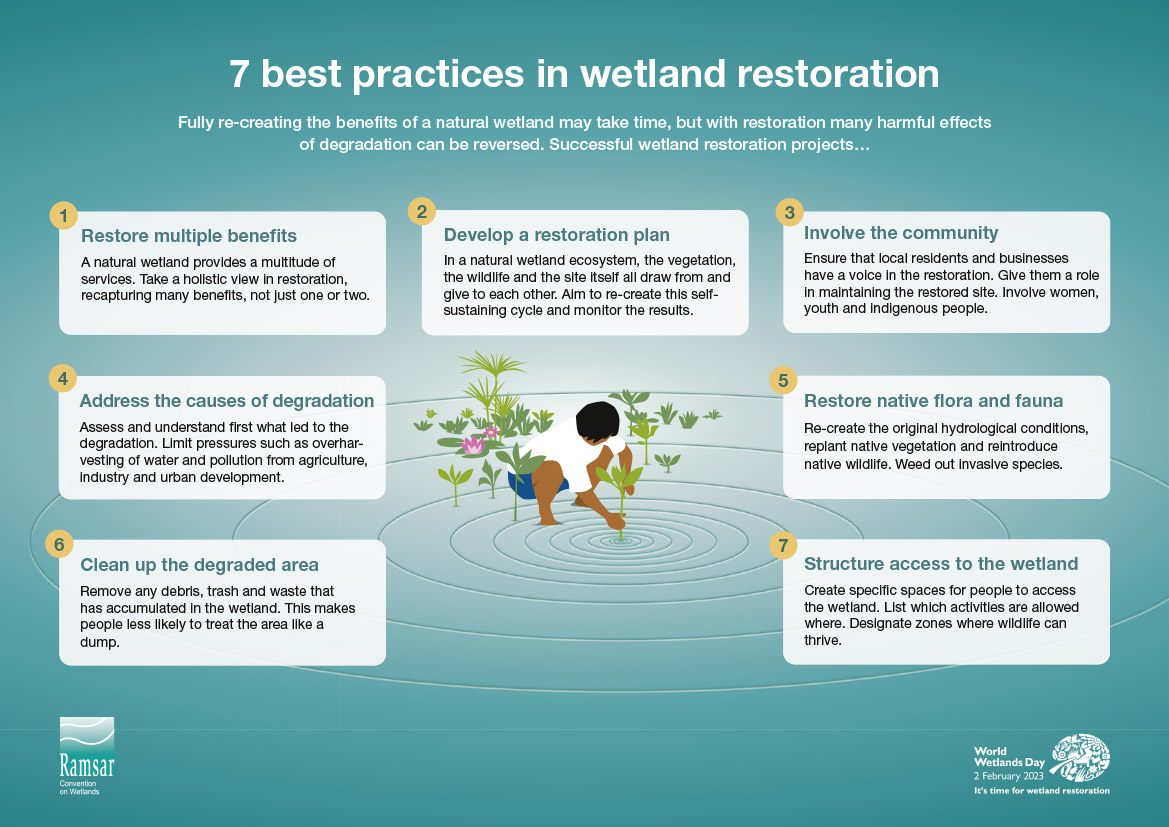
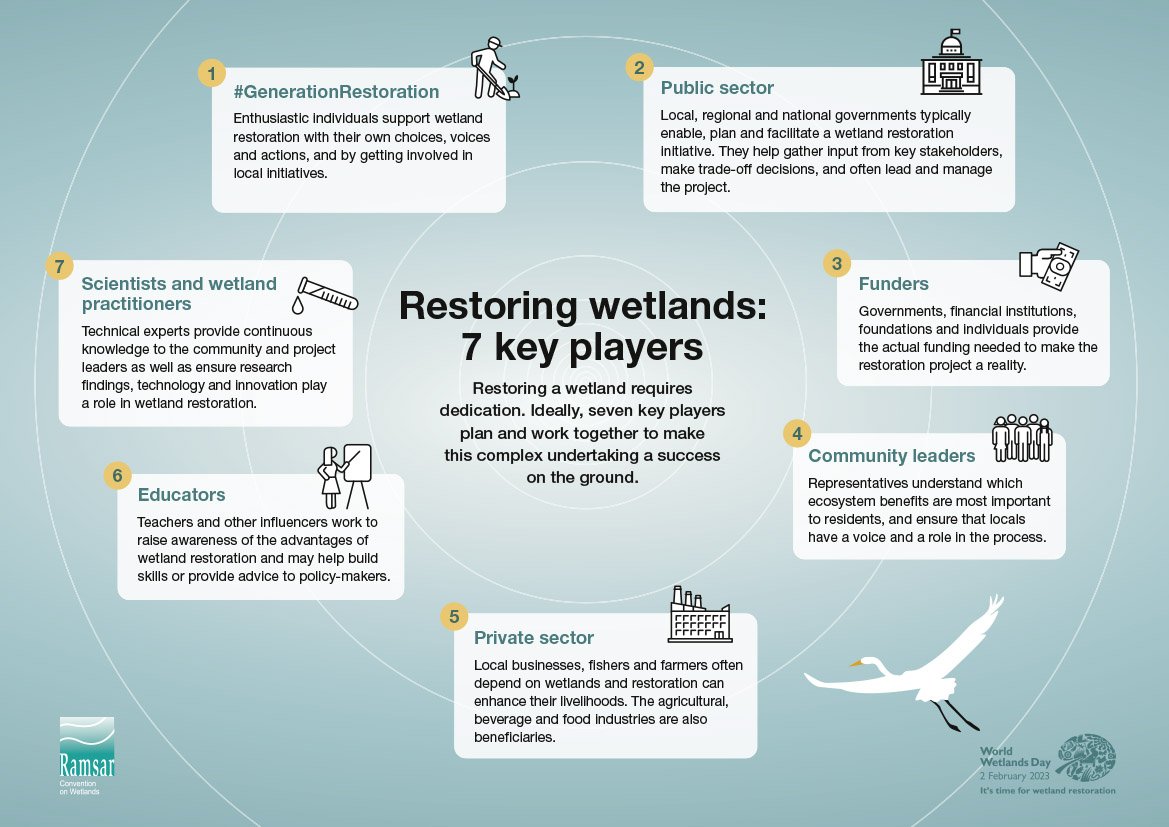
- Consider the multitude of services the natural wetland provided, and aim to recapture a wide range of those benefits, not just one or two.
- Aim to recreate a wetland ecosystem that can maintain itself
- Integrate local communities and industries during planning and implementation.
- Identify the causes of degradation and limit or eliminate them.
- Clean up the degraded area.
- Restore native vegetation and wildlife, and remove invasive species.
- Restrict site access, creating specific places for people and animals.
As we reflect on the ecological and cultural significance of Ramsar sites, it's imperative to recognize our collective responsibility to preserve these vital wetlands for future generations, ensuring the continuity of biodiversity and the sustenance of local communities that depend on them.
Previous Post